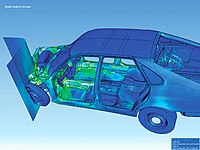
Photo from wikipedia
ABSTRACT A relatively simple finite element modeling approach – named the Fixed-Strut-Angle Finite Element (FSAFE) Model – is presented in this paper for simulating the hysteretic lateral load behavior of… Click to show full abstract
ABSTRACT A relatively simple finite element modeling approach – named the Fixed-Strut-Angle Finite Element (FSAFE) Model – is presented in this paper for simulating the hysteretic lateral load behavior of reinforced concrete structural walls with varying levels of flexural and shear deformation contributions on wall response. The behavioral characteristics of the constitutive panel elements incorporated in the model formulation are based on a fixed-crack-angle modeling methodology that also incorporates simple behavioral models for shear–aggregate interlock in concrete and dowel action on reinforcing bars, constituting the shear stress transfer mechanisms across the cracks. Model response predictions are compared with experimentally measured responses of selected wall specimens with varying geometry and reinforcement characteristics; including relatively slender (aspect ratio of 3.0) flexure-controlled walls with rectangular and T-shaped cross-sections, medium-rise walls (aspect ratios of 1.5 and 2.0) with coupled shear-flexural responses, and squat walls (shear span-to-depth ratios of 0.44 and 1.0) with shear-dominant responses. The FSAFE model demonstrates a reasonable level of accuracy in predicting the nonlinear hysteretic response of the wall specimens investigated. Accurate predictions are obtained for the experimentally measured lateral load vs. displacement response characteristics of the walls, including their lateral load capacity, sftiffness, and ductility, as well as their hysteretic response attributes. The model also provides reasonably accurate estimates of the relative contributions of nonlinear flexural and shear deformations to wall lateral displacements, as well as local deformation characteristics including the spreading of nonlinear flexural and shear deformations along wall height, the distribution of transverse normal strains along wall height, and the longitudinal strain profiles across the wall cross-section. It is identified that consideration of instability related wall failures, including buckling of reinforcement and out-of-plane instability of the wall boundary region, is necessary for further improvement of model accuracy.
Journal Title: Journal of Earthquake Engineering
Year Published: 2019
Link to full text (if available)
Share on Social Media: Sign Up to like & get
recommendations!